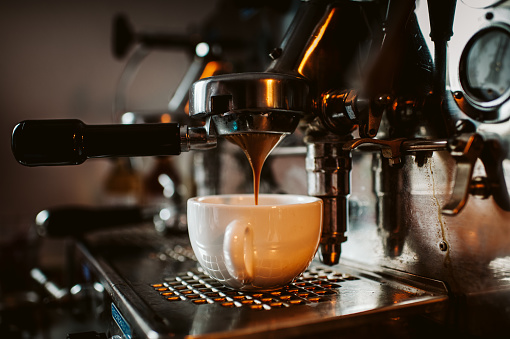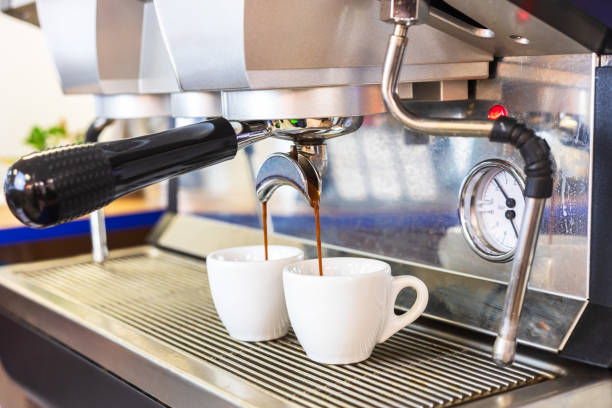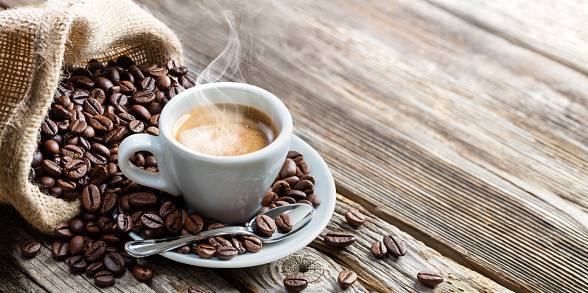Espresso, which means “quick” in Italian, is a rich Italian coffee extracted using the steam pressure of an espresso machine. Typically they use espresso in the drinks like Americano, café latte, and cappuccino.
The espresso extracts quickly for 20–30 seconds using 85–95 °C water, 7–10 grams of thinly ground beans, and a pressure of 8–10 bars. A glass of this extracted espresso contains roughly 20–30 ml. And the flavors will remove in the following order: sour, sweet, savory, and bitter. Coffee takes less time to extract than espresso, and the amount of caffeine dissolved in water is much less.
To extract the perfect espresso, you must first grasp the primary extraction method and procedure. The distinctions between the characteristics and extraction variables of the beans.
The oil component of coffee that is not dissolved in water divides the espresso into fine sizes, giving it a dispersed emulsion shape and a rich flavor and smooth texture. Espresso keeps the coffee’s warmth and aroma by covering the surface with a dark brown (or golden) froth layer called crema.
Contents
The Concept of Espresso
A Brief Introduction and History of Espresso Pressure Bars
As the coffee roasts, carbon dioxide fills the cell walls. The inside of the coffee beans becomes more porous during the roasting process, generating room within the cell walls. In addition, as the liquid in the coffee evaporates, the tissues expand owing to internal pressure.
There are volatile smells and solids in the space that make up the flavor of coffee, it creates by chemical processes produced by heat while the coffee is roasting. As we are effectively extracting them.
You can use different techniques to eliminate these coffee constituents. One of which distinguishes espresso coffee from other coffee extraction methods: is the use of pressure.

The espresso machine extracts the elements that make up the taste and aroma of coffee. Passing hot water through the chopped coffee layer at a high pressure of 9 to 15 bar generated by the motor pump.
The pressure dissolves the insoluble components of coffee oil and colloidal that do not dissolve in water. At this point, an emulsified crema will create by combining the two ingredients.
With the evolution of espresso machines, the pressure required to extract espresso has evolved. In the 1800s, filtered coffee was the norm in European coffee shops. The café was concerned about “how can I make more coffee faster?” because of the crowds.
In 1901, Luigi Bezzerra and Desiderio Pavoni devised a machine that used steam pressure between 1 and 2 bars, accelerating the popularization of espresso.
Achille Gaggia utilized a piston lever mechanism to raise the extraction pressure to 8 to 10 bar in 1946, allowing for the extraction of espresso with crema. While Faema devised a machine in 1961 that employed a motor pump to offer a more stable and consistent 9-bar pressure. 9 bars became the standard for espresso coffee extraction pressure over time.
The Reason for the Importance of the Pressure Bar for Espresso Machines

When the extraction water pressure is low, the coffee and the extraction water have a longer contact time. However, when the pressure is too high, the coffee and extraction water have a shorter contact time, it cannot extract all the good ingredients from coffee properly. As a result, the taste of coffee would be bitter.
Hence, the overall flavor would be light and not like a strong coffee. Accurate extraction pressure is very significant to have a delicious espresso.
When the bar pressure is 7, the coffee taste is bitter, and the flavor would be light when the bar pressure is 10. So, how many bars are ideal for a delicious cup of espresso? The answer is 9 pressure bars. That is the perfect bar pressure to get the most balanced espresso.
Espresso Bars Tips For A Perfect Cup of Espresso

Here are some common questions when it comes to choosing an espresso machine for a good bar pressure.
Why And When Is 9-bar Extraction Used For A Perfect Shot?
The essential design orientation of espresso machines has evolved from the early 1900s through the 2000s to extract coffee as quickly as possible. The faster extraction needed more power, and the time it took to extract coffee substantially impacted the efficiency and productivity of coffee shops.
During the first development period of espresso machine technicians, a series of tries, trials, errors, and customer satisfaction led to the creation of nine bars’ value. These statistics have been the standard in the espresso coffee market for decades.
Is it true that you are extracting coffee with a 9-bar For A Good Espresso?
So, are we extracting with real 9 bar pressure right now? Baristas sometimes can mistake the amount of pressure applied to the real coffee by the number displayed on the pressure gauge attached to the espresso machine.
The pressure gauge displays the pressure output from the pump, not the pressure received by the chopped coffee layer. If the extraction pressure is set to a pressure gauge, the group head will most likely be extracted at a lower pressure than the intended value when it reaches the pump.
Pressure and flow rates are closely connected in the production of espresso. The pressure applied to the chopped coffee layer determines how quickly the extraction passes through.
Even if the 9 bar output from the pump is applied to the group head, the pressure may vary depending on the coffee’s grinding particle density. The amount of ground coffee in the filter basket, and the density distribution.
The barista may selectively regulate the liquid pressure and flow rate to determine how much of the various components make up the coffee’s taste and aroma.
How do the aroma and taste differ between home coffee makers and cafe espresso machines?
Usually, people say that they are different in terms of bar pressure. And people also doubt the difference between expensive and affordable espresso machines. So, they are different in the time of maintaining the pressure. It is a matter of how well the espresso machine can hold the bar pressure.
If you are looking for an espresso machine for yourself, choosing the affordable one would not be a problem. Because you do not extract espresso for a whole day, you only need a few cups for your self-satisfaction.
However, the coffee specialty shops should have expensive espresso machines to serve customers quickly. If they let customers wait long due to a long extraction time, customer satisfaction would be lowered.
Current Bar Pressure Trends and Changes
Due to the advent of a range of ingredients and roasting techniques, discussions concerning espresso extraction pressures have been active over the past few years. The darkly roasted espresso blends are often utilized in the pressure profiling specialty coffee market.
In the past, 9 bars were first considered to be the standard. But currently, alternative pressure profiles for different coffees are being tried. These efforts result in a more detailed flavor profile.
Pressure profiling changes the pressure applied to the coffee layer while extracting the coffee. Existing coffee machines maintain constant pressure while extracting a glass of espresso. Still, high-end machines are exposed to procedures that allow them to be manually changed during extraction.
Finally, due to the fact that the components of the coffee significantly removed during the finishing phase (ramp down and extraction finish). The density of the coffee layer at this point is significantly reduced. In this case, it may be possible to obtain a positive effect by lowering the extraction pressure in the second half.
Final Thoughts
Many factors influence the taste and scent of coffee brews. In the case of espresso, the extraction procedure is further complicated by the addition of a variable called “pressure.”
But now there is various ways you can control the pressure. Thanks to technical developments, people can exploring, testing and studying coffee more easily. I believe that extraction techniques and machinery are improving and that we are on our way to a full cup of coffee.
Reference
- The Long History of the Espresso Machine | Smithsonian MAGAZINE | Jimmy Stamp
- How Many Bars Of Pressure Is Good For Espresso? | HOMEGROUNDS
Understanding Espresso: Pressure (Episode #6) By James Hoffmann
